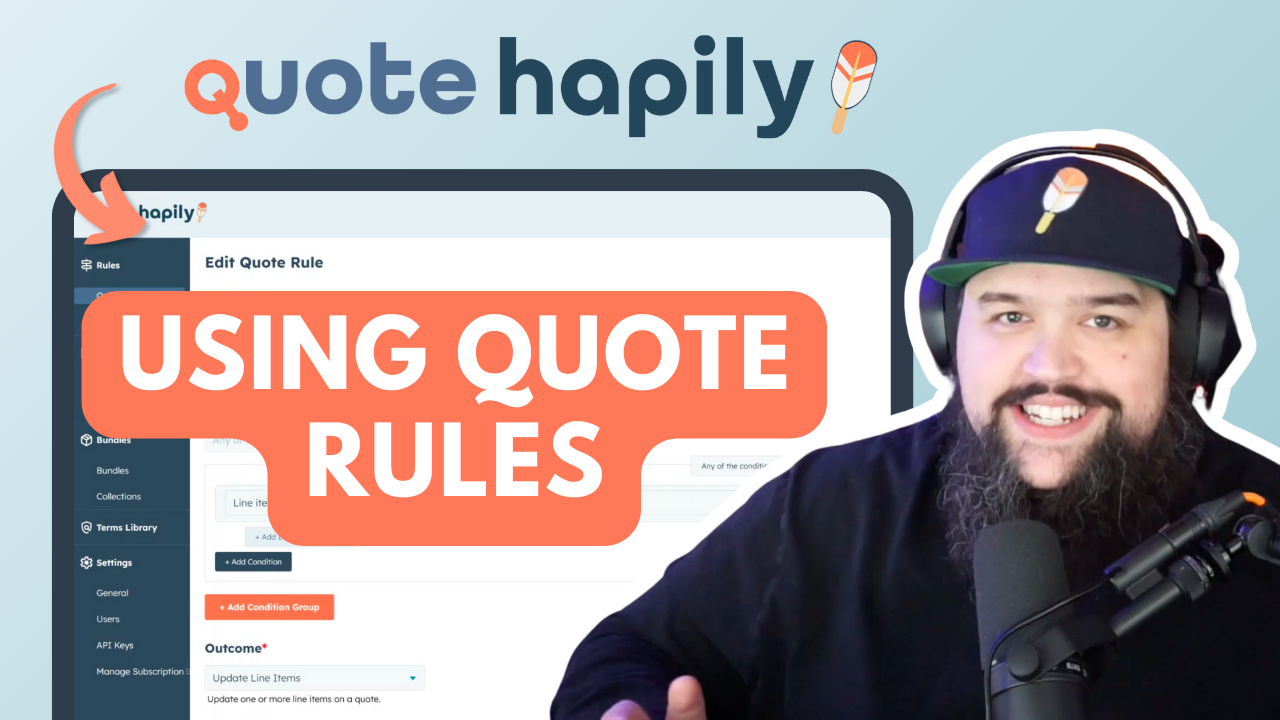If quoting inside HubSpot still involves reps applying discounts manually, remembering edge-case pricing rules, or checking the Slack channel for "how we do it for this product," you're not scaling, you're just surviving.
As your pricing strategy evolves and your team grows, you need automation that adapts with you. Not just to save time, but to ensure consistency, accuracy, and control across every quote that goes out.
That’s exactly where quote rules in quote•hapily comes in to turn your manual logic into automated enforcement directly inside HubSpot.
Want the TL;DR version instead? Watch Max dive into it here:
Why Quote Rules Are Core to Modern CPQ in HubSpot
Quote rules let you define conditional logic that automatically updates your quotes in real time based on deal context, product type, billing frequency, SKU, or almost any other property available in your CRM.
They go beyond “show this section” or “hide this field.” With the latest enhancement to quote•hapily, quote rules now support updating line item properties, meaning you can:
- Apply conditional discounts
- Lock fields to prevent rep edits
- Adjust pricing or quantities based on business rules
- Trigger dynamic logic by product, segment, term length, and more
What This Looks Like in Practice
Let’s take a simple but high-impact use case: a 10% discount for any product billed annually.
Here’s what happens with quote rules:
- A rep builds a quote, selects a product, and switches billing frequency from monthly to annual.
- quote•hapily detects that billing frequency = annual, applies a 10% discount, and locks the field so it can’t be changed.
No one has to remember the rule. No one has to check a spreadsheet. And Finance knows the margin was protected.
Why This Matters Beyond the Quote
When pricing strategy lives in people’s heads or Google Docs, it’s not enforceable. And if it’s not enforceable, it’s not scalable.
quote rules give you:
- Operational consistency
Every quote follows the same logic, no matter who builds it. - Stronger governance
Approvals are triggered when they should be. Discounts are controlled. Policies are enforced. - Real-time responsiveness
Rules can be tailored to products, customers, deal types, or lifecycle stages — and updated anytime without retraining reps. - Faster ramp-up
New reps don’t need to memorize pricing logic. They just follow the quote flow.
This is how you shift from sales-assisted quoting to truly intelligent quoting.
Use Cases That Drive Real Impact
This isn’t just about a few discount rules. Quote rules are flexible enough to handle nearly any logic you want embedded into your quoting process.
You can:
- Apply automatic discounts for annual, quarterly, or prepaid billing
- Create SKU-specific rules for promotional pricing
- Enforce read-only fields for regulated or fixed-cost products
- Trigger approval workflows when a quote includes high-value or high-discount items
- Update line items differently for hardware, software, or services based on product type
The power isn’t just in what you can do — it’s in how easily you can apply and update that logic across your entire sales org.
Product Deep Dive: How Quote Rules Actually Work
Once you’re inside quote•hapily, setting up a quote rule takes just a few steps — but the power comes from how specific you can get.
Every quote rule includes three main parts:
1. Define Your Trigger
This is the condition that must be true for the rule to activate. You can use virtually any property from the quote, deal, product, or line item. For example:
- If billing frequency equals “Annual”
- If product SKU starts with “SaaS-”
- If total quantity is greater than 50
- If deal stage is “Contract Sent”
- If line item discount is greater than 10%
You can combine multiple conditions to create compound logic and keep rules tightly targeted.
2. Select Targeted Line Items
You can choose to apply the rule to:
- All line items
- Only the ones that meet your filter criteria
- Specific products or categories based on name, SKU, or custom properties
This makes it easy to narrow down exactly which line items should be updated — whether you're applying a service-only rule or targeting just a promotional SKU.
3. Define the Outcome
Once the rule is triggered, quote•hapily will automatically update your selected line items. Outcomes can include:
- Setting a discount (percent or flat)
- Adjusting quantity or pricing
- Locking fields like unit price or discount so they’re read-only
- Triggering a separate quote approval requirement
- Adding internal notifications or custom messages for the rep
And because this all runs on the back of your HubSpot deal and quote infrastructure, you can track changes, update logic as pricing evolves, and run reporting on usage patterns over time.
One Rule Can Save Hundreds of Manual Edits
Even a single quote rule can eliminate hours of manual work and drastically reduce errors. Multiply that across reps, regions, and product lines — and it becomes foundational.
Whether you’re building out tiered pricing for SaaS, enforcing guardrails for hardware discounts, or rolling out seasonal promos that only apply to specific industries, quote rules give you a scalable, maintainable way to keep quoting logic consistent and enforced.
Tips for Building Smarter Quote Rules
If you're just getting started, keep your first few rules focused and impactful. Choose rules that solve a recurring problem or eliminate a common error.
Use clear naming conventions, document your logic, and avoid overlapping triggers when possible. And remember: you can test and preview quotes to make sure your rules are behaving exactly as intended.
This Is What Scalable CPQ Looks Like in HubSpot
Most quoting systems force you to choose between flexibility and control. quote•hapily lets you have both — by building automation into the quoting layer itself.
Quote rules let you:
- Govern pricing without slowing sales down
- Automate logic you’ve been enforcing manually
- Align your reps, your systems, and your strategy
- Make quoting smarter as you grow — not more complex
If you’re quoting in HubSpot and still relying on rep memory or post-send QA, quote rules are the infrastructure upgrade you’ve been waiting for.
👉 Want to see approvals in action? Request a demo to see how they can transform the way you quote, sell, and grow.



.png)
